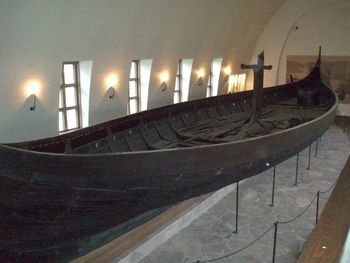Viking longship: Difference between revisions
imported>Anthony.Sebastian (formatting edits) |
imported>Anthony.Sebastian (add image) |
||
| Line 2: | Line 2: | ||
The [[Vikings]] were renowned for their seamanship, and in particular their distinctive longships which became emblematic of the Viking Age. The use longships, also known as longboats, lasted from the 9th century to the 11th, and influenced ship building across northern Europe.<ref>McGrail (1989), 38–43</ref> | The [[Vikings]] were renowned for their seamanship, and in particular their distinctive longships which became emblematic of the Viking Age. The use longships, also known as longboats, lasted from the 9th century to the 11th, and influenced ship building across northern Europe.<ref>McGrail (1989), 38–43</ref> | ||
{{Image|Viking Longship.jpg|right|350px|"The Gogstad Ship, excavated in 1880, dates to the late 9th century; it is housed in the Viking Ship Museum in Oslo. Constructed largely of oak, the vessel is 24 m long and 5 m wide and was built to carry 32 oarsmen."}} | |||
While there is variation in design over time and according to the purpose of the vessel, Viking longships have a number of common characteristics. They were symmetrical so the bow and stern, which rose above the rest of the ship, were the same shape. The vessels were [[clinker]]-built, meaning the timber planks of the hull overlapped. To make the structure waterproof, [[caulking]] was added in the form of a tar and animal hair mixture. <ref>McGrail (1989), 44–45</ref> Viking longships can be grouped by size: those small enough where a single rower could operate two oars (one on either side of the ship), and those where each rower operated just one oar.<ref>McGrail (1989), 46</ref> | While there is variation in design over time and according to the purpose of the vessel, Viking longships have a number of common characteristics. They were symmetrical so the bow and stern, which rose above the rest of the ship, were the same shape. The vessels were [[clinker]]-built, meaning the timber planks of the hull overlapped. To make the structure waterproof, [[caulking]] was added in the form of a tar and animal hair mixture. <ref>McGrail (1989), 44–45</ref> Viking longships can be grouped by size: those small enough where a single rower could operate two oars (one on either side of the ship), and those where each rower operated just one oar.<ref>McGrail (1989), 46</ref> | ||
Revision as of 21:22, 21 September 2012
The Vikings were renowned for their seamanship, and in particular their distinctive longships which became emblematic of the Viking Age. The use longships, also known as longboats, lasted from the 9th century to the 11th, and influenced ship building across northern Europe.[1]
While there is variation in design over time and according to the purpose of the vessel, Viking longships have a number of common characteristics. They were symmetrical so the bow and stern, which rose above the rest of the ship, were the same shape. The vessels were clinker-built, meaning the timber planks of the hull overlapped. To make the structure waterproof, caulking was added in the form of a tar and animal hair mixture. [2] Viking longships can be grouped by size: those small enough where a single rower could operate two oars (one on either side of the ship), and those where each rower operated just one oar.[3]
In warships, oarports were cut along the length of the hull, while in a trading vessel they were generally confined to the end of the ship while the middle was used to store cargo. The ships were swift, and their shallow draft meant they could be brought close to the shore, and even dragged onto land by the crew. In particular this allowed longboats to penetrate further up shallow rivers than other boats.[4] The boats were effective when used to facilitate raiding, for instance Vikings raided up the River Seine in 865, and pillaged the monastery of St Denys.
In areas affected by Viking raids nobles took measures to defend against such attacks. One such example is the construction of two fortified bridges to block the path of the ships. In Zeeland, nobles chose to build fortifications rather than blocking the route of longships. Another common response to the raids was for kingdoms to build their own ships.[5]
